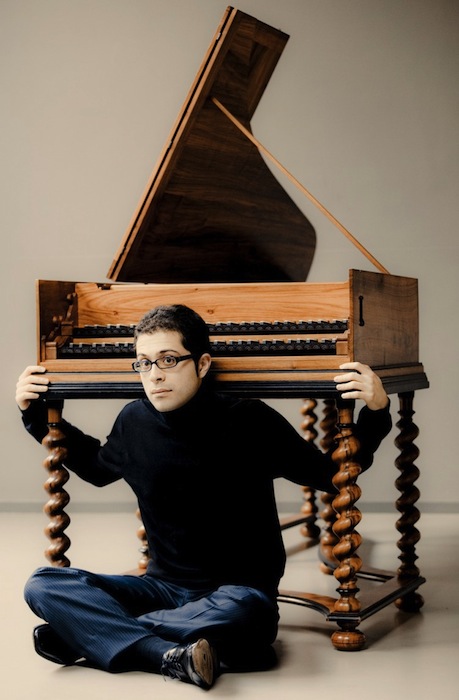An old instrument is made new again by probing harpsichordist Mahan Esfahani

Harpsichordist Mahan Esfahani performed in the Da Camera of Houston series Tuesday night at the Menil Collection.
Mahan Esfahani has picked up the harpsichord gauntlet in a century-old campaign.
Since Wanda Landowska premiered works by Manuel de Falla and Francis Poulenc in the 1920s, harpsichordists have attempted to rescue their instrument from the exclusive confines of the 16th and 17th-century and show that it can not only still be relevant give voice to the music of their own times.
In his recital Tuesday at the Menil Collection, Mahan Esfahani carried on the fight in style. Relatively brief works by William Byrd and J.S. Bach were the only “old” pieces the Iranian-American musician performed. The rest of his program, presented b Da Camera of Houston, showcased 20th and 21st-century, from keyboard innovator Henry Cowell to living composers Kaija Saariaho and Steve Reich. Banishing the harpsichord’s stereotype as the piano’s jingly, stiff ancestor, Esfahani brought vigor, color, expression and atmosphere to his performances.
The trills and embellishments of Byrd’s Pavane “Passing Measures” didn’t come across like mere decoration; rather, Esfahani’s deft touch molded them into a flowing lyricism that moved from one voice in the texture to another. When Bach’s Toccata in F-sharp Minor turned toward melody, Esfahani’s supple tempos let the music breathe; the gentle rise and fall of momentum kept the lines alive and meaningful.
That fluidity was just as compelling in newer pieces. Esfahani brought out the improvisatory feel of Toru Takemitsu’s Rain Dreaming, a meditative piece that hinted a bit at what a Debussy harpsichord work might sound like. In Three Aquarelles by Czech composer Viktor Kalabis–husband of harpsichordist Zuzana Ruzyckova, one of Esfahani’s teachers–Esfahani’s sensitivity to the flow and interaction of musical lines let him make the most of the second sketch’s two simple strands. (During the first Kalabis vignette, a cellphone rang, and its owner was so slow to silence it that Esfahani called out, “Not now!” He asked if it was off before he started the second.)
Half-shades of color also played a role. By adding or silencing the harpsichord’s brighter tones, for instance, Esfahani made the works’ contrasts of texture and motion all the more telling—full versus spare, deep-voices against high, swirling versus calm.
The harpsichord may not be able to thunder like a piano, but Cowell’s Set of Four proved that it can be commanding on its own terms. With a chorale and a fugue among its movements, the suite had strong Baroque overtones. The opening Rondo’s big, sonorous chords harked back to majestic Bach preludes. The Ostinato mimicked the motoric energy of Baroque allegros. The Chorale unleashed still more ringing chords, and Esfahani’s agility and emphasis let him relish Cowell’s grand gestures; the contrast between chords he strummed and those he landed on full-force helped shape the music’s character.
Two works paired the harpischord with recordings. In Esfahani’s arrangement of Reich’s Piano Phase for duo keyboards–both playing the same line, but moving in and out of sync–he performed one part live while his recording of the other sounded from the speakers. The changing overlap of the two parts created shifting sonorities and hints of melody, and the harpsichords’ bite and ringing tone added their own unique flavor to the familiar piano version.
Saariaho’s Jardin Secret II enveloped the harpsichord in electronic phantasmagoria. The synthesizer-generated sounds included high-pitched chattering with avian tinges and what seemed to be a person exhaling–maybe through a toneless wind instrument.
The music sometimes let fly with washes of sound, sometimes with pounding rhythm. The harpsichord fired back with trills, chords and other strokes. But the most arresting passage was the close: a deep, dark sonority like the tolling of a church bell hovered in the background, as Esfahani spun out a spacious, introspective solo. In his hands, the subtlety that served Bach so well did the same with Saariaho..


